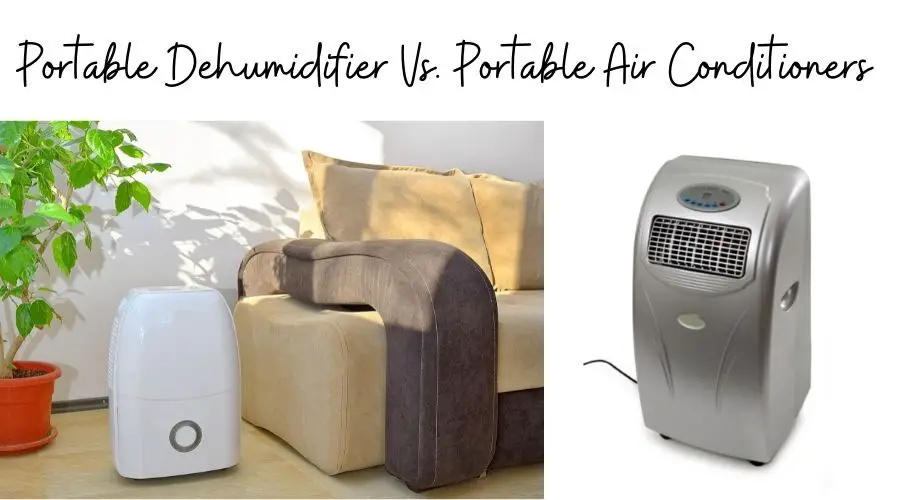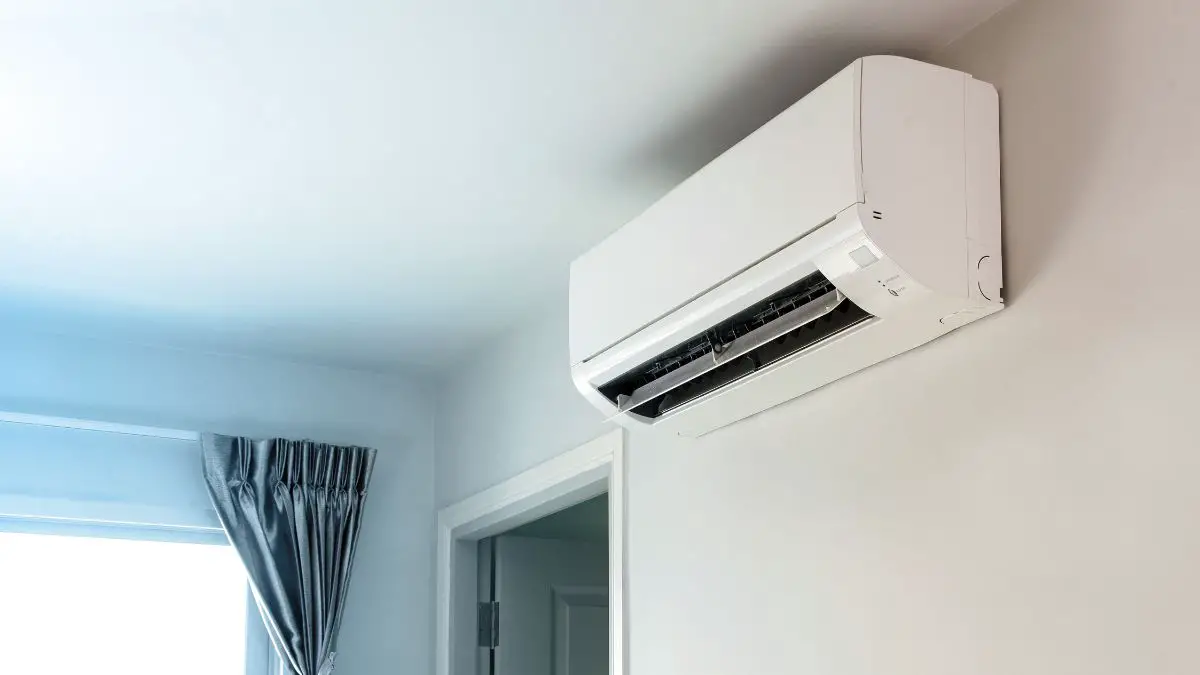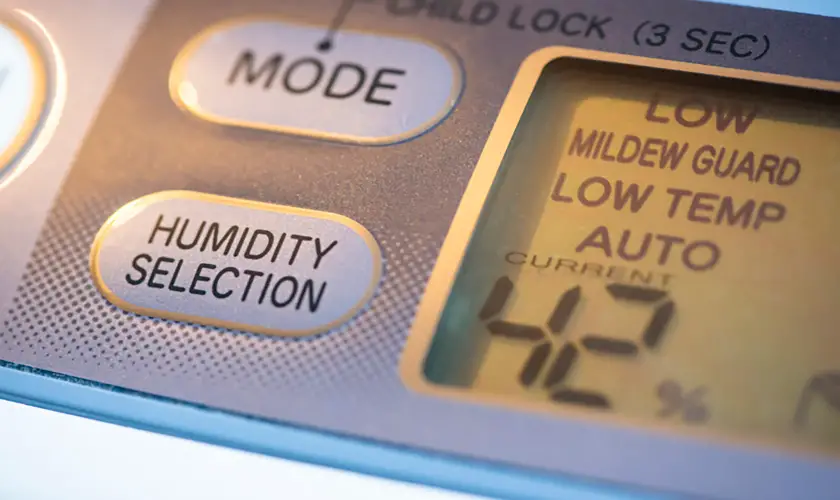
When it comes to making your living space more comfortable, there are two significant appliances that you should be looking at. These appliances are portable air conditioning units and portable dehumidifiers.
Both of these units work to accomplish the same thing. However, they do so in different ways and with different effectiveness.
When comparing a dehumidifier and an air conditioner, you will see that they do the same thing. Both work to cool and dehumidify the air.
However, dehumidifiers do so with different effectiveness. For instance, a dehumidifier’s primary goal is to remove moisture from the air while also cooling the air.
At the same time, a portable air conditioner’s primary goal is to cool the air while also dehumidifying it.
With that said, get a dehumidifier if you need to remove moisture from the air more than cool it down. Get a portable air conditioner if you need to make the air nice and cold more than remove humidity.
As you continue to read this article, it will go more in-depth about each appliance. Not only that, but this article will also compare and contrast both dehumidifiers and portable air conditioners to help you figure out which is best for you.
Portable Dehumidifiers vs. Portable Air Conditioners: What’s the Difference?
| PORTABLE DEHUMIDIFIER | AIR CONDITIONER |
|---|---|
| Helps you live more comfortably | Helps you live more comfortably |
| Removes moisture in the air | Focuses on cooling the air |
| Saves money and energy | Is more expensive to run |
| Makes the room feel cooler due to removing humidity in the air. | Makes the room colder due to removing the heat out of the air. |
| Helps you sweat less due to lack of humidity. |
While dehumidifiers and portable air conditioners work to make your living more comfortable, they achieve it differently.
As previously stated, a dehumidifier’s primary goal is to remove moisture from the air; cooling it is a side effect. A portable air conditioner’s goal is the opposite: cooling the air rather than removing moisture.
That said, the costs to operate both devices are vastly different. Running a portable air conditioner will always be more expensive than running a dehumidifier.
Air conditioners cost more because it takes more electricity to cool down a square foot of air than to remove humidity from that same square foot of air.
The reason air conditioners are more expensive to run comes down to the science of energy use. Cooling something down will always require more energy than warming something up.
Not only that but the more drastic the temperature change, the more power is needed.
Because dehumidifiers make a room more comfortable by removing and redistributing humidity in the air, it makes it feel cooler than it is. It feels cooler because it allows your skin to absorb the sweat it naturally produces.
The more humid it is, the more water your skin will drink from the air. This makes the sweat you produce form droplets on your skin.
Benefits of Using a Dehumidifier or Portable Air Conditioner?
There are plenty of benefits that come with the use of an air conditioner or a dehumidifier. But, first, let us talk about air conditioners.
The primary benefits of using an air conditioner are filtering air or providing a cooler atmosphere to live and work.
Portable Air Conditioner & Dehumidifier Benefits
1. Air Filtration
Due to how air conditioners cool air, the air it processes is blown through one or more filters. As air is blown through these filters, the air is purified. The filter catches dust, hair, dirt, and other airborne contaminants.
Even studies show evidence that air filtration through air conditioners can help reduce pathogens that can cause asthma.
2. Provides A Colder Atmosphere
The cold air that is produced by an air conditioner has a multitude of positive effects. Firstly, the most prevalent benefit is comfortability. Nothing is better than coming home from work to relax in a pleasant temperature-controlled atmosphere.
There are other beneficial effects to the cold air produced by air conditioners. Working in a cool warehouse or working out in a temperature-controlled gym can make your work more efficient.
Not only that, but the cool air from the air conditioner reduces the likelihood of heatstroke and dehydration.
When considering the benefits of using a dehumidifier, you tend to see many health-related benefits surrounding asthma and allergies. However, you will also notice the comfortability in rooms where you are using your dehumidifier increases.
Dehumidifier Benefits
1. Reduces The Chance Of Your Home Growing Mold
Mold is possibly one of the worst things for any homeowner. Mold and mildew are also one of the leading causes of developing allergies. With that said, mold grows in warm damp environments.
Dehumidifiers’ primary purpose is to remove moisture from the air. Removing water from the air will stunt the growth of any developing mold and mildew in your home.
2. Reduces The Dust Mite Population In Your Home
Dust mites are microscopic insects that live just about everywhere in the world. Large populations of dust mites in a home can cause allergies to flare up.
Running a dehumidifier in your home is a fantastic way to reduce dust mite populations. Dust mites thrive most in areas where the air is extremely humid.
Therefore, removing moisture from the air will make dust mites want to leave for a more hospitable place to live.
There are more benefits for both portable dehumidifiers and portable air conditioners. However, most have already been spoken about in the article above.
Should I Use a Portable Dehumidifier or a Portable Air Conditioner?
Choosing which appliance to use in your home mainly comes down to a few factors.
- What do you want to use it for?
- Are you prone to allergies or other respiratory issues?
- The typical weather where you live
- Personal preference
These are the things you need to ask yourself when looking to purchase either a portable dehumidifier or a portable air conditioner.
Get an air conditioner if you want your device to make rooms colder simply. It will work to cool you off after a long day while also removing some of the moisture in the air.
Do you live near the ocean, a large lake, or a river? Then getting a dehumidifier would be great to remove all the extra moisture that those bodies of water bring into your home.
If you or someone in your family prone to respiratory issues? A dehumidifier is a perfect choice for you. You may also consider a portable air conditioner with a powerful dehumidifier setting.

How Do Portable Air Conditioners Work?
Most people are accustomed to living with an air conditioner. They work to make the air where you live, relax, and work more comfortable.
However, the process by which air conditioners can cool the air can be a bit complicated. The process starts with the thermostat you have mounted on your wall.
The thermostat monitors and controls the inside air temperature. It is often mounted on a wall in a central location of the house.
When the thermostat senses that the air temperature needs to be reduced, it sends signals to the heating and cooling components both in and out of the home, instructing them to begin functioning.
The fan on the interior unit draws hot air from home via return air ducts. This air is sent through filters, which capture dust, lint, and other airborne particles. The filtered, heated interior air subsequently passes over the cold evaporator coil.
The heat from the interior air is absorbed into the refrigerant as the liquid refrigerant inside the evaporator coil changes to gas, cooling the air as it travels over the coil.
The cold air is pumped back through the ductwork by the indoor unit’s blower fan and into the different living spaces.
The refrigerant gas exits the house via a copper tube and enters the compressor in the outside air conditioner unit. Consider the compressor to be a significant electric pump.
A compressor compresses the refrigerant gas and directs it to the external unit’s condenser coil. A huge fan draws exterior air through the condenser coil, letting the air collect and release thermal energy from the dwelling.
The refrigerant is turned back to a liquid during this procedure. It then returns to the indoor unit through a copper tube.
It goes through an expansion mechanism that regulates the coolant flow into the evaporator coil. The cool refrigerant takes more heat from the interior air, and the cycle repeats.
Remember that a tiny amount of refrigerant is lost during the process in which your air conditioner cools down air.
Whether this coolant loss is due to imperfections made by the manufacturer or wear and tear caused by continual use, eventually, you will need to “recharge” the refrigerant.
During the cooling process, moisture is removed from the air inside the air conditioner. Because the air is being cooled, the water vapor will condense into liquid as the air around it cools down.
The water forms on the condenser coils and is effectively removed from the air. This is why all air conditioners have a drip tray or a drainage line to eliminate excess water.
While some portable air conditioning units are much better at eliminating humidity, their primary goal is to cool the air.
With that said, plenty of portable air conditioners on the market sport a dry or dehumidifier mode. With this mode turned on, your air conditioner will work to remove more moisture from the air than it usually would.
During this process, the air that passes over the condenser coils stays inside the unit longer. Because the air remains next to the coils longer, more moisture can be removed from the air.
However, the amount of water removed from the air by air conditioners with a dry or dehumidifier mode still does not remove as much as you would be able to with a dehumidifier.
How Do Portable Dehumidifiers Work?
There are two different types of dehumidifiers. The first type of dehumidifier works similar to how an air conditioner works.
1. Condensing Dehumidifier
This dehumidifier relies on refrigerant to cool the air around its evaporator coils, like an air conditioner.
As the air passes through the evaporator coils, the moisture in the air forms droplets of water on the coils. The water droplets that appear on the coils form due to a process called condensation.
These droplets will keep forming and eventually drip down into the water collection bucket at the bottom of the dehumidifier.
As the air continues through the dehumidifier, it passes over the condenser coils and the compressor. The compressor and its coils radiate heat, slightly warming the air.
Once the air gets somewhat warmed by these parts, a fan will push it back into the room.
When the now drier warm air reenters the room’s atmosphere, it allows the remaining humidity of the room to redistribute to the dry air.
As the moisture redistributes, the atmosphere in the room becomes more comfortable and will feel more relaxing.
This is because the humidity is measured by the amount of water in the air. The hotter the air, the more water vapor it can hold.
Because your dehumidifier removed water from part of the air that is now floating around your room, it gives the water vapor still in the air more room to move around.
As your dehumidifier continues to pull in moist air and let out dry, warm air, the overall humidity level in the room will become thinner and less pronounced.
2. Desiccant Dehumidifier
The second type of dehumidifier is known as a desiccant dehumidifier. These dehumidifiers pull in air and pass it over some desiccant material located inside the dehumidifier.
A perfect example of a desiccant material is the packets of silica you find in shoe boxes or beef jerky bags.
These little baggies of silica work to absorb any moisture that comes into the immediate area. Desiccant materials are hygroscopic materials that absorb water from the air.
The process in which desiccant dehumidifiers work is even simpler than the refrigerant dehumidifier. A desiccant dehumidifier will use a fan to draw in moist air from the room around it.
As the air passes through the device, it is pushed through a large filter filled with desiccant material. When the air passes through this material, moisture is absorbed into it before being moved back out into the room using another fan.
Because these types of dehumidifiers do not require any form of heating or cooling to remove moisture from the air, they are ideal for areas that experience extreme cold.
Final Thoughts
The differences between a portable dehumidifier and a portable air conditioner should be apparent after reading this article.
Dehumidifiers work to remove moisture from the air and make it more comfortable.
At the same time, air conditioners work to make the air cooler while also removing some water from the air. The choice on which you want or need to get falls entirely on you and your needs.







